News
As Xamarin.Forms Nears End-of-Life, Uno Platform Throws Hat into Replacement Ring
With Microsoft's Xamarin.Forms mobile-centric UI toolkit for .NET developers nearing its end-of-life date of May 1, the open source Uno Platform is throwing its hat into the ring as a possible replacement.
Developers have long known of Xamarin.Forms sunsetting, with Microsoft helpfully offering up its .NET MAUI as the "evolution" of the framework thanks to the added ability to use it for desktop apps as well as the traditional iOS and Android targets.
This week, Uno Platform, having focused on Xamarin.Forms migration, offered up another option, complete with a case study of how a large enterprise migrated from Xamarin.Forms to its .NET-centric tech.
 [Click on image for larger view.] Uno Platform (source: Uno Platform).
[Click on image for larger view.] Uno Platform (source: Uno Platform).
The open source Uno Platform project claims to be the only offering that enables development of single-codebase applications for Windows, WebAssembly, iOS, macOS, Android and Linux, targeting all OSes and browsers. The Uno team has also teamed up with Redmond on various projects and has sometimes implemented new tech before Microsoft itself.
The case study published this week, titled, "Toyota migrates mobile app to Uno Platform," starts out with:
Companies often face the daunting task of adapting their digital infrastructure to stay ahead. Toyota, a titan in the automotive industry, found itself at such a crossroads when the end-of-life announcement for Xamarin.Forms prompted it to reevaluate its mobile application development strategy.
This article explores Toyota's transition from Xamarin.Forms to Uno Platform, highlighting how it navigated the challenges of migrating complex applications and achieved successful deployments, all while adhering to the stringent standards set by Toyota.
Spearheading that transition was a sophisticated quality inspection and traceability tool, a crucial application created with Xamarin.Forms. It leveraged the Azure Mobile SDK customized specifically for Toyota's unique cloud infrastructure and featured advanced functionalities and included advanced features such as:
- Tailored form designs for pop-ups
- Virtual keyboard management
- HTML text formatting within Xamarin.Forms labels
- Gesture recognition for extended presses
Further speaking to the sophistication and complexity, barcode scanning, a critical part of quality inspection, was improved by integrating Zebra's Xamarin SDK for handheld devices and Honeywell's Captuvo SDK for iOS sleds, along with the Zxing.Net Mobile library for camera-based scanning.
 [Click on image for larger view.] Transition App Stack (source: Uno Platform).
[Click on image for larger view.] Transition App Stack (source: Uno Platform).
One thing Uno Platform's post didn't mention was .NET MAUI, which would seem to be the logical choice for those invested in Xamarin.Forms.
Of course, Uno Platform boasts some .NET MAUI chops of its own, having worked with the technology and offering up its own .NET MAUI Embedding controls.
Visual Studio Magazine reached out to the company to learn more about the use case of a developer or team or shop that might choose Uno Platform over .NET MAUI as a migration path.
"What I've observed in the .NET community is that if a significant effort is needed to migrate from Xamarin.Forms to .NET MAUI, then companies look at the options they have," replied Sasha Krsmanovic, CMO at the company. "And once they look at the options, they start to see the migration as an opportunity to add new features and expand to new platforms, such as Linux or web.
"A recent example of considering options was Bitwarden, who in that particular case chose to go with two codebases -- Swift and Kotlin -- for their iOS and Android apps. Going native, with two or even more codebases, may be an option for some companies, as that approach has its own serious drawbacks. What we see is companies looking to target as many platforms as possible with a single codebase, using the tools and platforms that get them to ship and iterate fast, all while still staying with .NET."
Anyway, with major enterprises like Toyota having planned for Xamarin.Forms EOL from the very first sunsetting announcement, time is running out for too-busy individuals or procrastinating teams to make a migration decision: native, .NET MAUI, Uno Platform, or ....
About the Author
David Ramel is an editor and writer at Converge 360.